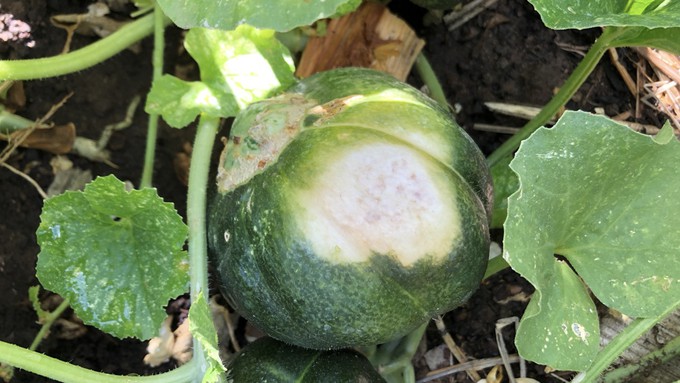
Weather service declares 'Excessive Heat Watch' for Sacramento region

In very hot weather, squash and melons can get sunburned, too. Protect ripening vegetables before the high heat hits. For vining plants, stake shade cloth over the growing area, or put folded paper "hats" on each potential sunburn victim. Kathy Morrison
Earlier Friday, the National Weather Service declared an “Excessive Heat Watch,” in effect from Tuesday morning, Ju;y 2, to next Friday night, July 5. That includes the July Fourth holiday and many planned outdoor celebrations.
“Heat could significantly impact outdoor holiday activities,” says the weather service. “Hottest temperatures are expected beginning Wednesday and continuing into next weekend.”
Be careful jumping into the American River or other cool spots. “Area waterways will continue to run cold and fast, creating dangerous conditions for those seeking relief in rivers and lakes,” says the weather service.
How hot will it get? “Dangerously hot conditions with high temperatures of 105 to 115,” says the weather service. “Limited overnight relief with low temperatures in the upper 60s to around 80. The result will be widespread Major to Extreme Heat Risk.”
The forecast for downtown Sacramento looks torched. After a weekend in the high 90s (10 degrees above normal), Sacramento is expected to hit 104 degrees Monday, and each day after just keeps getting hotter. The current forecast for July 4 in Sacramento: 109 degrees. Normal for that date: 90 degrees.
Although it has a well-earned reputation for summer heat, Sacramento isn't always crispy on the Fourth of July. The high on that holiday last year: 88 degrees.
The coming heat wave will be at its worst in the Sacramento Valley, northern San Joaquin Valley and surrounding foothills, predicts the weather service. Record highs could be hit in the cities of Sacramento, Modesto, Red Bluff, Marysville, Yuba City, Grass Valley, Stockton, Jackson, Chico, Paradise, Oroville, Alder Springs and Redding.
“Heat-related illnesses increase significantly during extreme heat events, particularly for those working or participating in outdoor activities,” warns the weather service.
Due to hot nights, mornings will be unusually warm, too. Sacramento could be in the 80s by 9 a.m.
If you have garden tasks, get them done as early as possible. Water in the early morning.
Also take other precautions:
* Provide temporary shade for seedlings and plants sensitive to sunburn, such as peppers and eggplants.
* Make sure mulch surrounds vegetable plants; it keeps roots cool and retains moisture.
* Check soil moisture before irrigating, but plants likely will need extra water during this heat spell, especially large-leafed squash and melons.
* It’s normal for plants to wilt in the afternoon during such heat. But if they’re still wilted in the morning, give them a drink.
The weather service adds these reminders:
* Drink plenty of fluids, stay in an air-conditioned room, stay out of the sun, and check up on relatives and neighbors.
* Do not leave young children and pets in unattended vehicles. Car interiors will reach lethal temperatures in a matter of minutes.
* Monitor the latest forecasts and warnings for updates.
For forecast updates and more information: https://www.weather.gov/sto/.
Comments
0 comments have been posted.Sacramento Digs Gardening to your inbox.
Sites We Like
Garden Checklist for week of Nov. 3
November still offers good weather for fall planting:
* If you haven't already, it's time to clean up the remains of summer. Pull faded annuals and vegetables. Prune dead or broken branches from trees.
* Now is the best time to plant most trees and shrubs. This gives them plenty of time for root development before spring growth. They also benefit from fall and winter rains.
* Set out cool-weather annuals such as pansies and snapdragons.
* Lettuce, cabbage and broccoli also can be planted now.
* Plant garlic and onions.
* Keep planting bulbs to spread out your spring bloom. Some possible suggestions: daffodils, crocuses, hyacinths, tulips, anemones and scillas.
* This is also a good time to seed wildflowers and plant such spring bloomers as sweet pea, sweet alyssum and bachelor buttons.
* Rake and compost leaves, but dispose of any diseased plant material. For example, if peach and nectarine trees showed signs of leaf curl this year, clean up under trees and dispose of those leaves instead of composting.
* Save dry stalks and seedpods from poppies and coneflowers for fall bouquets and holiday decorating.
* For holiday blooms indoors, plant paperwhite narcissus bulbs now. Fill a shallow bowl or dish with 2 inches of rocks or pebbles. Place bulbs in the dish with the root end nestled in the rocks. Add water until it just touches the bottom of the bulbs. Place the dish in a sunny window. Add water as needed.
* Give your azaleas, gardenias and camellias a boost with chelated iron.
* For larger blooms, pinch off some camellia buds.
* Prune non-flowering trees and shrubs while dormant.
* To help prevent leaf curl, apply a copper fungicide spray to peach and nectarine trees after they lose their leaves this month. Leaf curl, which shows up in the spring, is caused by a fungus that winters as spores on the limbs and around the tree in fallen leaves. Sprays are most effective now.